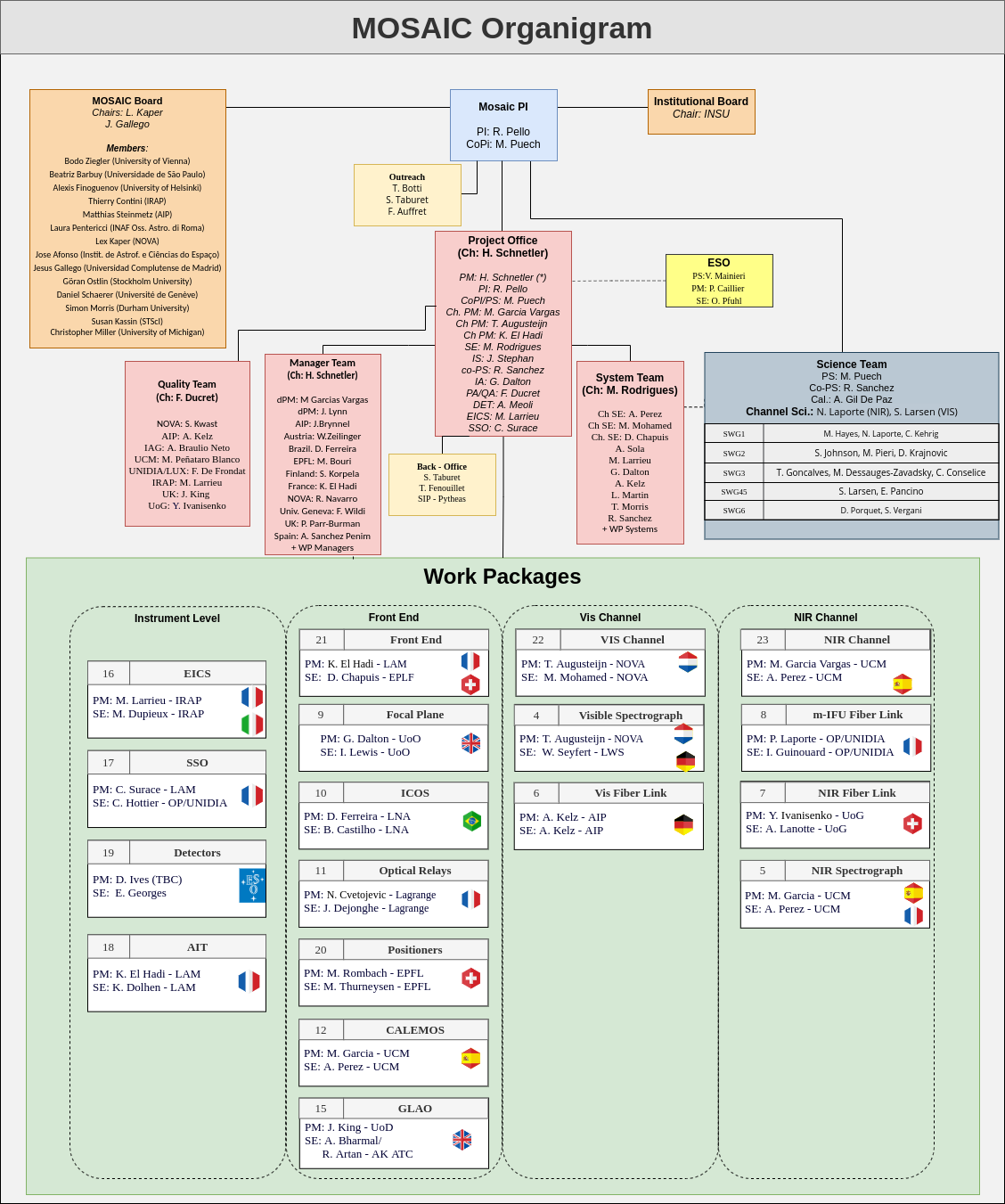|
| ||
The project development plan breaks down into the following major phases with some sub-phases:
- Phase B is aimed at flowing all specification down to modules and achieve a preliminary design maturity. This phase is separated into two:
- Phase B1: More concentrated in the flow down of requirement and architecture definition to sub- system level
- Phase B2: Preliminary design activities.
- Phase C is aimed at achieving the final design of the instrument up to component. It ends with the final design reviews to free the Manufacturing drawings definition.
- Phase D will cover the manufacturing, system AIV/T and instrument AIT/V. This phase will end with the Preliminary Acceptance in Europe.
- Phase E will cover the activities of packing, shipping and preliminary acceptance in Chile.
Project management board
The MOSAIC Board has the role of assisting the PI in all the different phases and aspects of the Project. It is the supervisory structure of the Consortium. The members of the MOSAIC Board are the Co-Is, which represent each participating country. The PI, co-PI and PM are invited to all meetings of the MOSAIC Board. The main role of the management board is to follow the milestones of the project in coordination with the PIs, to review the Consortium Agreement, and to organize the scientific and financial support of MOSAIC. The current board Chair and Deputy Chair are Lex Kaper and Jesus Gallego, respectively. The committee is composed of : Jose Afonso (IA, Lisbon Univ.), Portugal - Beatriz Barbuy (IAG, Sao Paulo), Brazil - Christopher J. Miller (Univ. of Michigan), USA – Thierry Contini (Toulouse, IRAP), France - Alexis Finogenov (Helsinki Univ.), Finland - Jesus Gallego (Madrid, Computense Univ.), Spain - Lex Kaper (Amsterdam Univ.), Netherlands - Susan Kassin (STScI), USA - Simon Morris (Durham Univ.), U.K. - Goran Ostlin (Stockholm Univ.), Sweden - Laura Pentericci (INAF-Osservatorio Astronomico di Roma), Italy - Matthias Steinmetz (AIP, Potsdam), Germany - Daniel Schaerer (Univ. of Geneva), Switzerland - Bodo Ziegler (Vienna Univ.), Austria | ||
The MOSAIC project brings together the design and analysis work done on all previous conceptual designs for a MOS for the ELT. As we saw in previous section, the MOSAIC Consortium includes world-leaders in the design, development, and construction of astronomical instrumentation, located across Europe and Brazil, and supported as high priority by their funding agencies. Partners within the MOSAIC consortium have a long and successful heritage of instrument delivery for ESO, including: FLAMES, KMOS, MUSE, SPHERE, NACO, VIMOS, and X-SHOOTER. Partners within the MOSAIC consortium also have a long and successful heritage of instrument delivery for the Spanish 10.4m GTC telescope, including MEGARA and EMIR. This makes available the skills needed to develop MOSAIC whatever the area: Adaptive Optics, Fibres, Spectrograph, Interfaces with the telescope, etc. The MOSAIC instrument concept is now under development and will provide a versatile, facility-class instrument, capable of addressing a broad range of key science topics enabled by the size and adaptive optics of the ELT. Following Figure 3-1 illustrates the skills of the consortium especially with respect to Spectrographs and Adaptive Optics:
Work Package DescriptionsMOSAIC will be one of the most complex instruments ever built for ground astronomy. Therefore, the project is defined in a detailed Work Breakdown Structure. The proposed hierarchy decomposes the work in to a manageable quantity highlighting the scope of each package. | ||

